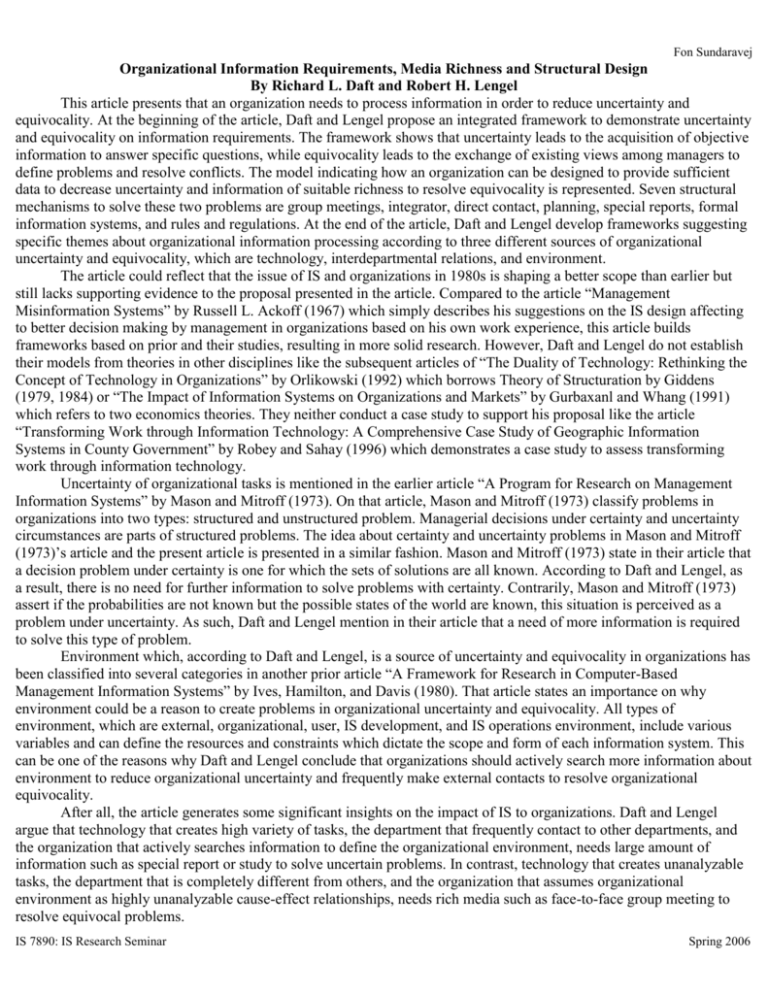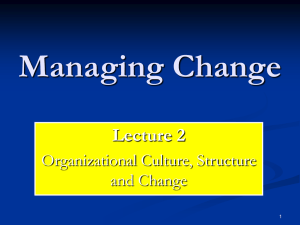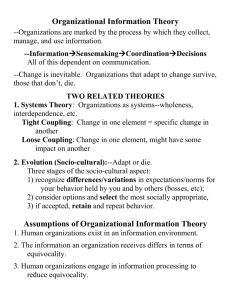Organizational Information Requirements, Media Richness and
advertisement

Fon Sundaravej Organizational Information Requirements, Media Richness and Structural Design By Richard L. Daft and Robert H. Lengel This article presents that an organization needs to process information in order to reduce uncertainty and equivocality. At the beginning of the article, Daft and Lengel propose an integrated framework to demonstrate uncertainty and equivocality on information requirements. The framework shows that uncertainty leads to the acquisition of objective information to answer specific questions, while equivocality leads to the exchange of existing views among managers to define problems and resolve conflicts. The model indicating how an organization can be designed to provide sufficient data to decrease uncertainty and information of suitable richness to resolve equivocality is represented. Seven structural mechanisms to solve these two problems are group meetings, integrator, direct contact, planning, special reports, formal information systems, and rules and regulations. At the end of the article, Daft and Lengel develop frameworks suggesting specific themes about organizational information processing according to three different sources of organizational uncertainty and equivocality, which are technology, interdepartmental relations, and environment. The article could reflect that the issue of IS and organizations in 1980s is shaping a better scope than earlier but still lacks supporting evidence to the proposal presented in the article. Compared to the article “Management Misinformation Systems” by Russell L. Ackoff (1967) which simply describes his suggestions on the IS design affecting to better decision making by management in organizations based on his own work experience, this article builds frameworks based on prior and their studies, resulting in more solid research. However, Daft and Lengel do not establish their models from theories in other disciplines like the subsequent articles of “The Duality of Technology: Rethinking the Concept of Technology in Organizations” by Orlikowski (1992) which borrows Theory of Structuration by Giddens (1979, 1984) or “The Impact of Information Systems on Organizations and Markets” by Gurbaxanl and Whang (1991) which refers to two economics theories. They neither conduct a case study to support his proposal like the article “Transforming Work through Information Technology: A Comprehensive Case Study of Geographic Information Systems in County Government” by Robey and Sahay (1996) which demonstrates a case study to assess transforming work through information technology. Uncertainty of organizational tasks is mentioned in the earlier article “A Program for Research on Management Information Systems” by Mason and Mitroff (1973). On that article, Mason and Mitroff (1973) classify problems in organizations into two types: structured and unstructured problem. Managerial decisions under certainty and uncertainty circumstances are parts of structured problems. The idea about certainty and uncertainty problems in Mason and Mitroff (1973)’s article and the present article is presented in a similar fashion. Mason and Mitroff (1973) state in their article that a decision problem under certainty is one for which the sets of solutions are all known. According to Daft and Lengel, as a result, there is no need for further information to solve problems with certainty. Contrarily, Mason and Mitroff (1973) assert if the probabilities are not known but the possible states of the world are known, this situation is perceived as a problem under uncertainty. As such, Daft and Lengel mention in their article that a need of more information is required to solve this type of problem. Environment which, according to Daft and Lengel, is a source of uncertainty and equivocality in organizations has been classified into several categories in another prior article “A Framework for Research in Computer-Based Management Information Systems” by Ives, Hamilton, and Davis (1980). That article states an importance on why environment could be a reason to create problems in organizational uncertainty and equivocality. All types of environment, which are external, organizational, user, IS development, and IS operations environment, include various variables and can define the resources and constraints which dictate the scope and form of each information system. This can be one of the reasons why Daft and Lengel conclude that organizations should actively search more information about environment to reduce organizational uncertainty and frequently make external contacts to resolve organizational equivocality. After all, the article generates some significant insights on the impact of IS to organizations. Daft and Lengel argue that technology that creates high variety of tasks, the department that frequently contact to other departments, and the organization that actively searches information to define the organizational environment, needs large amount of information such as special report or study to solve uncertain problems. In contrast, technology that creates unanalyzable tasks, the department that is completely different from others, and the organization that assumes organizational environment as highly unanalyzable cause-effect relationships, needs rich media such as face-to-face group meeting to resolve equivocal problems. IS 7890: IS Research Seminar Spring 2006







